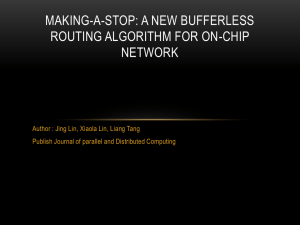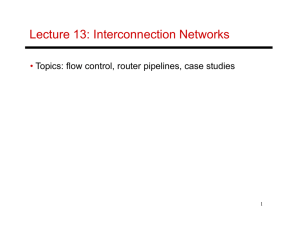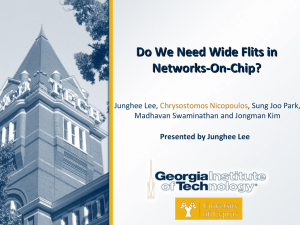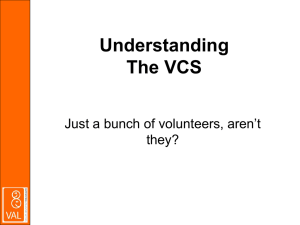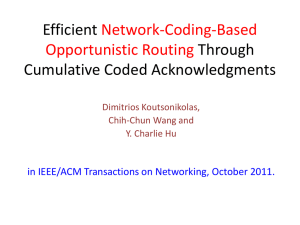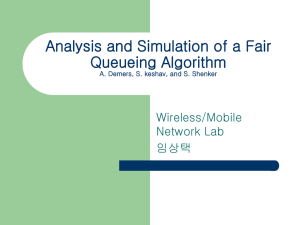NoC Basics
advertisement
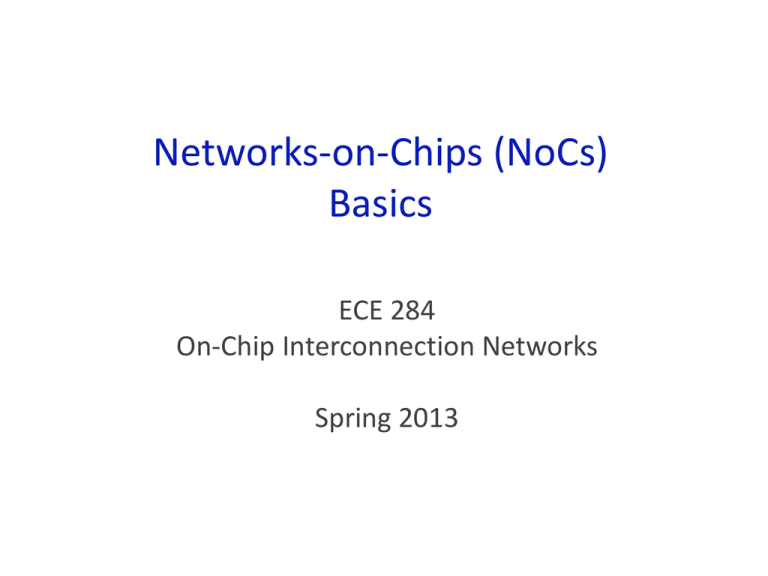
Networks-on-Chips (NoCs)
Basics
ECE 284
On-Chip Interconnection Networks
Spring 2013
Examples of Tiled Multiprocessors
• 2D-mesh networks often used as on-chip fabric
12.64mm
I/O Area
single tile
1.5mm
21.72mm
2.0mm
Tilera Tile64
2I/O Area
Intel 80-core
Typical architecture
Compute Unit
Router
CPU
L1
Cache
Slice of L2 Cache
• Each tile typically comprises the
CPU, a local L1 cache, a “slice” of a
distributed L2 cache, and a router
Router function
• The job of the router is forward packets from a source
tile to a destination tile (e.g., when a “cache line” is
read from a “remote” L2 slice).
• Two example switching modes:
– Store-and-forward: Bits of a packet are forwarded only after
entire packet is first stored.
– Cut-through: Bits of a packet are forwarded once the header
portion is received.
Store-and-forward switching
Buffers
for data
packets
Store
Source
end node
Destination
end node
Packets are completely stored before any portion is forwarded
[adapted from instructional slides of Pinkston & Duato, Computer Architecture: A Quantitative Approach]
Store-and-forward switching
Forward
Store
Requirement:
buffers must be
sized to hold
entire packet
Source
end node
Destination
end node
Packets are completely stored before any portion is forwarded
[adapted from instructional slides of Pinkston & Duato, Computer Architecture: A Quantitative Approach]
Cut-through switching
Buffers for data
packets
Requirement:
buffers must be sized
to hold entire packet
• Virtual cut-through
Source
end node
Destination
node
Buffersend
for flits:
packets can be larger
than buffers
• Wormhole
Source
end node
Destination
end node
[adapted from instructional slides of Pinkston & Duato, Computer Architecture: A Quantitative Approach]
Cut-through switching
• Virtual cut-through
Buffers for data
packets
Requirement:
buffers must be sized
to hold entire packet
(MTU)
Busy
Link
Packet completely
stored at
the switch
Source
end node
Destination
node
Buffersend
for flits:
packets can be larger
than buffers
• Wormhole
Busy
Link
Source
end node
Packet stored
along the path
Destination
end node
[adapted from instructional slides of Pinkston & Duato, Computer Architecture: A Quantitative Approach]
Packets to flits
Transact.
Type
Message
Type
Packet
Size
Read
Request
1 flit
Read
Reply
1+n flits
Write
Request
1+n flits
Write
Reply
1 flit
[adapted from Becker STM’09 talk]
Wormhole routing
• Head flit establishes the connection from input port
to output port. It contains the destination address.
• Body flits goes through the established connection
(does not need destination address information)
• Tail flit releases the connection.
• All other flits blocked until connection is released
Deadlock
Virtual channels
• Share channel capacity between multiple data
streams
– Interleave flits from different packets
• Provide dedicated buffer space for each virtual
channel
– Decouple channels from buffers
• “The Swiss Army Knife for Interconnection Networks”
– Prevent deadlocks
– Reduce head-of-line blocking
– Also useful for providing QoS
[adapted from Becker STM’09 talk]
Using VCs for deadlock prevention
• Protocol deadlock
– Circular dependencies between messages at network edge
– Solution:
• Partition range of VCs into different message classes
• Routing deadlock
– Circular dependencies between resources within network
– Solution:
• Partition range of VCs into different resource classes
• Restrict transitions between resource classes to impose partial order
on resource acquisition
• {packet classes} = {message classes} × {resource classes}
[adapted from Becker STM’09 talk]
Using VCs for flow control
• Coupling between channels and buffers causes head-of-line blocking
–
–
–
–
Adds false dependencies between packets
Limits channel utilization
Increases latency
Even with VCs for deadlock prevention, still applies to packets in same class
• Solution:
– Assign multiple VCs to each packet class
[adapted from Becker STM’09 talk]
VC router pipeline
•
Route Computation (RC)
– Determine candidate output
port(s) and VC(s)
– Can be precomputed at
upstream router (lookahead
routing)
•
Per packet
Virtual Channel Allocation (VA)
– Assign available output VCs to
waiting packets at input VCs
•
Switch Allocation (SA)
– Assign switch time slots to
buffered flits
•
Switch Traversal (ST)
– Send flits through crossbar
switch to appropriate output
Per flit
[adapted from Becker STM’09 talk]
Allocation basics
• Arbitration:
– Multiple requestors
– Single resource
– Request + grant vectors
• Allocation:
– Multiple requestors
– Multiple equivalent resources
– Request + grant matrices
• Matching:
– Each grant must satisfy a request
– Each requester gets at most one grant
– Each resource is granted at most once
[adapted from Becker STM’09 talk]
Separable allocators
• Matchings have at most one grant per row and per
column
• Implement via to two phases of arbitration
Input-first:
– Column-wise and row-wise
– Perform in either order
– Arbiters in each stage are fully independent
• Fast and cheap
• But bad choices in first phase can prevent second
stage from generating a good matching!
[adapted from Becker STM’09 talk]
Output-first:
Wavefront allocators
• Avoid separate phases
– … and bad decisions in first
• Generate better matchings
• But delay scales linearly
• Also difficult to pipeline
•
Principle of operation:
– Pick initial diagonal
– Grant all requests on diagonal
• Never conflict!
– For each grant, delete requests
in same row, column
– Repeat for next diagonal
[adapted from Becker STM’09 talk]
Wavefront allocator timing
• Originally conceived as fullcustom design
• Tiled design
• True delay scales linearly
• Signal wraparound creates
combinational loops
– Effectively broken at priority
diagonal
– But static timing analysis
cannot infer that
– Synthesized designs must be
modified to avoid loops!
[adapted from Becker STM’09 talk]
Diagonal Propagation Allocator
• Unrolled matrix avoids
combinational loops
• Sliding priority window
activates sub-matrix cells
• But static timing analysis
again sees false paths!
– Actual delay is ~n
– Reported delay is ~(2n-1)
– Hurts synthesized designs
[adapted from Becker STM’09 talk]
20
VC allocation
• Before packets can proceed through router, need to
acquire ownership of VC at downstream router
• VC allocator matches unassigned input VCs with
output VCs that are not currently in use
– P×V requestors (input VCs), P×V resources (output VCs)
• VC is acquired by head flit, inherited by body & tail
flits
[adapted from Becker STM’09 talk]
VC allocator implementations
• Not shown:
– Masking logic for busy VCs
[adapted from Becker STM’09 talk]
Typical pipelined router
RC
VA
SA
ST
LT
route
computation
VC + switch
allocation
switch
traversal
link
traversal
